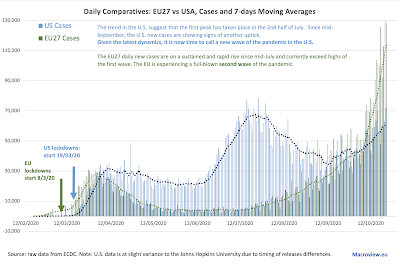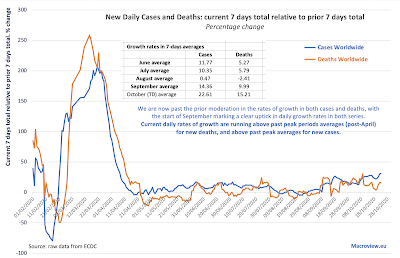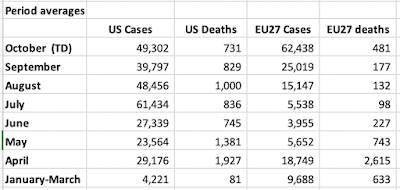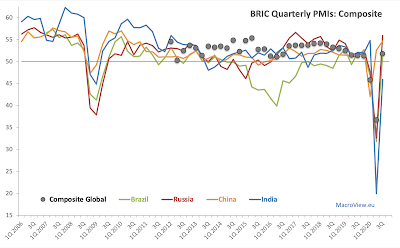Some interesting updates to the league tables for countries with > 100,000. Since the last update, five more countries joined the rather sad club, including Sweden (more on this later), and there are now 47 countries around the world with more than 100,000 cases of the disease recorded.
The tables below are organized as a heat map, with green cells reporting statistics that put a country in the 'better than average' category, while orange cells marking countries statistically worse than average:
- The EU27 - ranked relative to the countries, though excluded from the national level statistics inputs - is ranked 17th worst in the table.
- The U.S. is now jointly ranked 7th worst with the UK - a one point deterioration in performance for thee U.S. since the earlier update.
- Sweden ranks 15th worst - poorer performance than the EU27, but not by much.
- Globally, the worst impacted country is Peru, followed by Belgium and Bolivia (tied for the 2nd rank), Brazil (4th) and Chile (5th).
- The U.S. accounts for 4.34% of the world population, but holds a steady 20% share of global cases and deaths.
- The EU27 accounts for 5.92% of the world population, and holds 11% of world's cases and 14% of world's deaths.
- BRIICS+ Turkey account for 46.5% of world's population, 39% of world's cases and 30% of world's deaths.
- Sweden's infection rate is 25th highest in the world, which is basically identical to the EU's ranks of 26th. In actual numbers, Sweden's rate is only 1.68% higher than that of the EU27.
- However, Sweden ranks 15th in the mortality rate per capita of population (575.95 per 1 million of population), where as thee EU27 ranks 19th (361.33 per 1 million of population). Actual rate in Sweden is 59.4% higher than in the EU27.
- Sweden also ranks much worse than the EU27 in the COVID19 deaths per infection rate: Sweden is ranked 8th worst in the world, against the EU27 rank of 12th worst. Sweden has COVID19 mortality rate of 54.5 per 1,000 cases, the EU27 rate is 34.7.
- Sweden did not shut down its economy. But it is not doing better than all other economies that did. There are a total of 39 advanced economies in the world, including Sweden. In 2020-2021 growth outlook (cumulated forecast over 2 years), Sweden ranks 16th highest growth. Not exactly terribly, but not great either.
- In 2020-2021, based on IMF's October 2020 forecasts, Sweden's real GDP is expected to end 2021 at 98.59, relative to 100 for the end of 2019. Worse than Norway at 100.62, and Finland at 99.45 and Estonia at 99.07 and Denmark at 98.84, but better than the Netherlands at 98.43.
- Hardly an impressive performance for a 'herd immunity' country that is in more recent weeks enjoying post-peak troughs.




























